Newport, Rhode Island: The sailor’s mecca isn’t just for the rich and famous but it certainly looks the part

NEWPORT, R.I. — I am prone, on my back at the bow of an 80-foot sailboat with my foot propped atop the railing. If I moved 12 inches to my left, the sun would set between my feet. But I’m too relaxed to budge. The glass of champagne in my hand convinces me that there’s no better place in the world right now than sailing in the Sailing Capital of the World.
My girlfriend, the lovely and uber-talented photographer Marina Pascucci, is sitting behind me. The descending sun and lights of one of the world’s prettiest harbors reflect off her glasses like fireworks. Her beaming smile reminds me of the same one she flashed in Positano and Paris.
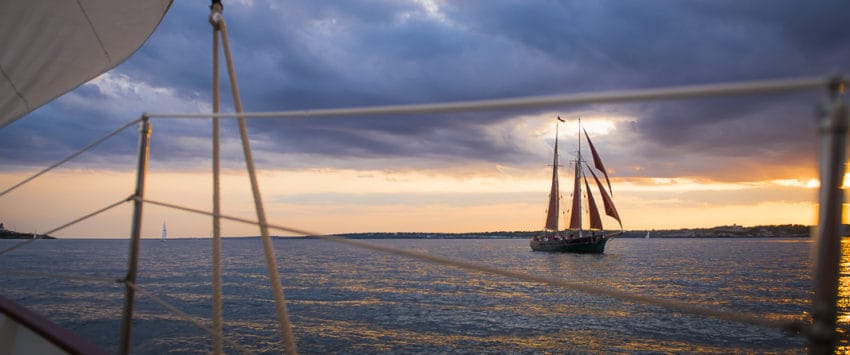
Welcome to Newport, R.I. It’s a combination of Camelot and Monaco, America’s answer to every desperate immigrant’s question since they first started storming our shores: What is the American Dream?
Marina and I finished our nine-day New England trip with a visit to some friends who are living that dream. Gretchen and Peter Bloom have lived in Newport off and on since 1988. I met them in Rome where they lived for 17 years and escaped every sweltering summer to Newport. They haven’t changed their routine since moving from Rome to Washington two years ago.
She’s retired from the World Food Program and Peter, a native of Providence, R.I., 40 miles up the road, is retired from USAID. Between the two, they’ve been to 123 countries, including 40 in Africa. They lived in Sri Lanka. Yet there is no place in the world — not Rome, not London, not the beaches of Thailand — they’d rather be than Newport.
“I wanted a piece of Rhode Island,” Peter tells me. “I am a Rhode Islander. You have no idea how much of a Rhode Islander.”
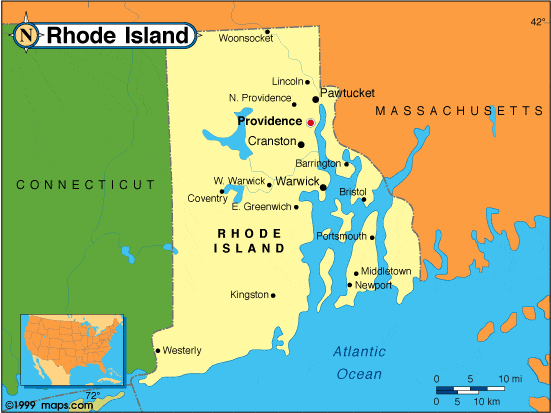
He’s telling me this while we sit in their fifth-floor condo on a long deck overlooking historic, majestic and magnetic Newport Harbor. After three days, I learned how much of a Rhode Islander he is. It goes beyond the fact that this Harvard grad still pronounces my home state “Or-ee-GONE.” He’s as proud of Newport as I am of Oregon. He puts down his glass of wine and sweeps his hand across the bay. Pleasure craft from small motorboats to towering sailboats dot the harbor, some drifting in from a cruise around the Rhode Island Sound.
Newport is to sailing what Aspen is to skiing. That’s why Marina and I found ourselves on a sunset booze cruise of an 80-foot windjammer. The America’s Cup, the international sailing championship founded in 1851, was held here from 1930-1983. John F. Kennedy’s old boat is here. Ted Turner’s famed champion, American Eagle, is docked here. So is Intrepid, which won the America’s Cup twice. The International Sailing Hall of Fame is negotiating to move here from Annapolis, Md.

It’s not just sailboats. Jimmy Buffett has here a 245-foot yacht, the fourth-largest private boat in the world. Race car driver Roger Penske has a 200-footer. The harbor in Monaco may have more expensive yachts. But Monaco doesn’t have Newport’s ambiance, its casual sense of bliss. In Monaco, you go to be seen. In Newport, you go to do.
The Blooms go sailing but are smart enough not to own a sailboat. I’ve met too many people who say, “The second best day of my life was when I bought my boat; the best day of my life was when I sold it.” While boats may be money pits, they are the most leisurely way to travel. I’ve done week-long sailing trips in French Polynesia, the Bahamas and the British Virgin Islands. Marina has sailed around Greece. There is no more restful sleep in the world than on the deck of a sailboat rocking on the South Pacific under a Polynesian sky. Peter was working in Lagos, Nigeria, in 1968 when he learned to sail 15-foot dinghies.
“I’m living in the sailing mecca of the world and I learned to sail in Lagos, Nigeria,” he says.
The Blooms actually live on Goat Island, a narrow islet less than a mile long and connected to Newport’s dock-lined southern shore by a short causeway. Goat Island is where they buried pirates they hanged in the 17th and 18th centuries, back when Newport rivaled New York as the most important port in the colonies. It later housed the Naval Torpedo Station until 1951. Today the Blooms look down along Goat Island’s southern shore lined with 19 modest harbor homes starting at about $1.3 million.
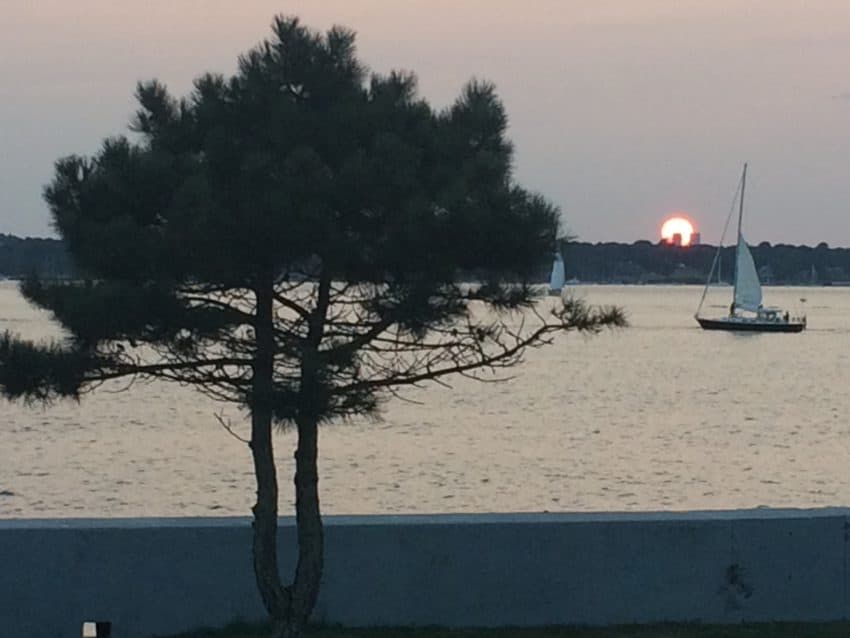
Romantic gazebos are spaced along the shoreline. Four big tables with chairs are pointed west for us to sit around and eat smoked gouda and drink good wine while a blood red sunset paints itself along the horizon. As the sun touches down, cannons go off from Newport’s three yacht clubs.
It’s the perfect spot for a wedding reception. In Newport, we were lucky to find a free gazebo. Newport is the nation’s second most popular wedding spot behind Las Vegas. But, as one local said, “Most of the weddings in Las Vegas are at 6 a.m. so I like to think Newport is No. 1.”
Every night we hear wild wedding receptions pulsating from a nearby building, forcing The Temptations’ “My Girl” to swirl in my head on a continual loop the next day.
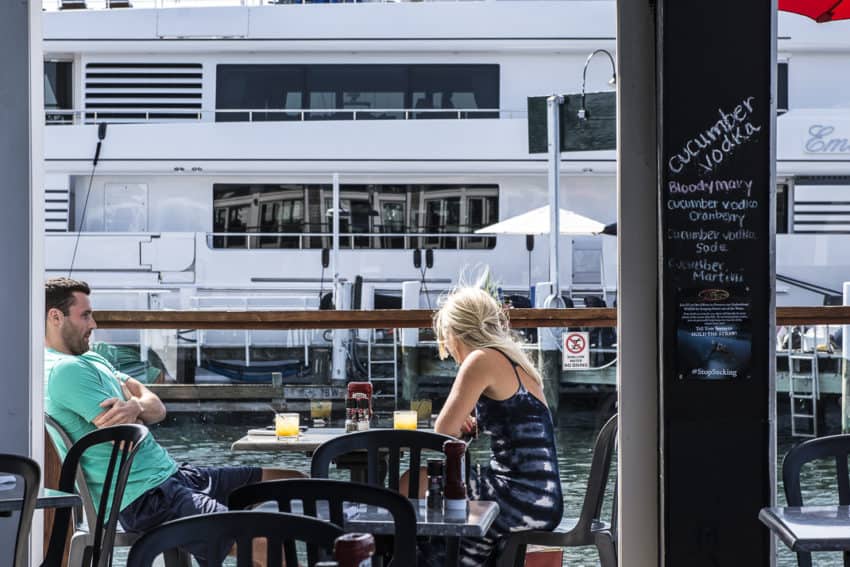
Walking around Newport, Marina and I feel like we’re exploring a nautical gingerbread land. The boating theme is everywhere on the long, straight boulevards lined with curiosity shops, tony cafes, sweet stands and souvenir stores. Down Thames Street we see U.S. flags with anchors in place of the stars. Flipflops sport fish on the soles. Jewelry are in the shape of nautical flags. A studio shows Onne Van Der Wal’s brilliant photos of giant sails and bows bopping up and down on the water, basked in a sunset. Then we pass the greatest name for a tackle store in the history of fishing.
Bite Me Bait Shop.
Try explaining that to an Italian woman still learning English. I admit, I had fun trying.
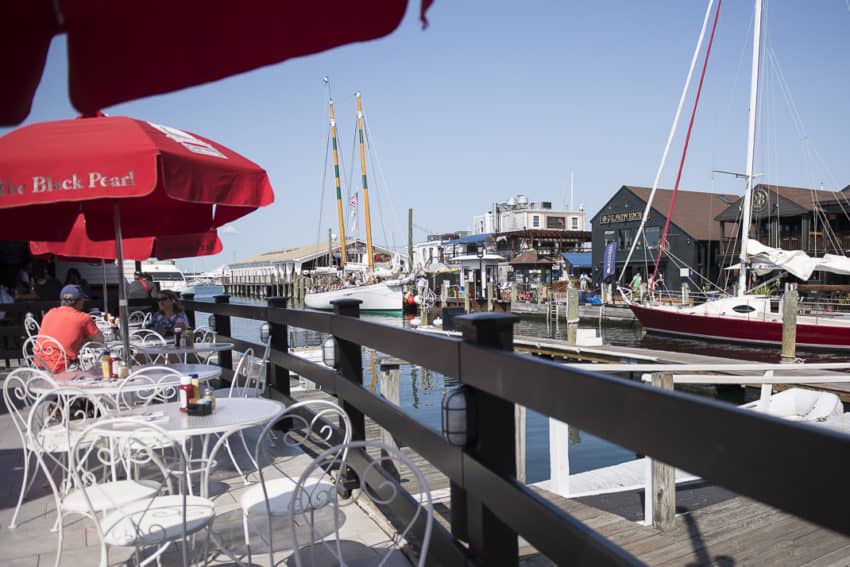

Newport’s action, however, is on the harbor. It’s like its own separate city. The southern shore of Newport is crawling with the breadth of American boating: kayaks, dinghies, motorboats, 15-foot skiffs, 22-foot J-class, historical windjammers. We walk in and out through the maze of shops and seafood restaurants and open-air bars where people eat thick clam chowder, drink big mugs of ice-cold beer and listen to The Doors’ “Light My Fire” over the loudspeaker. We can’t walk five minutes without running into little booths advertising harbor cruises scheduled from morning to sunset.
The Blooms pick us up and give us, not the nickel tour, but the million-dollar tour, which is the only way you can describe Newport. We drive by Washington Square, a wide swath of an area where they use a more civilized means of punishing thieves: a courthouse. People in red uniforms and black, three-point hats and wigs walk around in preparation for a reenactment of the Stamp Act protest from 1765. That’s when locals rioted over the British laying a tax on printed paper, one of the first direct taxes the British forced onto the colonies. We pass St. Mary’s Church where JFK married Jackie Bouvier, who grew up on nearby Hammersmith Farm, one of Newport’s mansions that became Kennedy’s summer White House. Later we see a photo of the Kennedys cutting their wedding cake.

We pass the International Tennis Hall of Fame, a miniature Wimbledon complete with the green wood architecture and grass courts. Two weekend hacks look astonishingly out of place wearing all whites while patty-caking shots across the net in front of an empty grandstand.
As we go by the massive gray-and-white Renaissance-Norman mansion used to house the New York Yacht Club, I ask Peter how much it costs to be a member.
“I’ll never get inside,” he says.
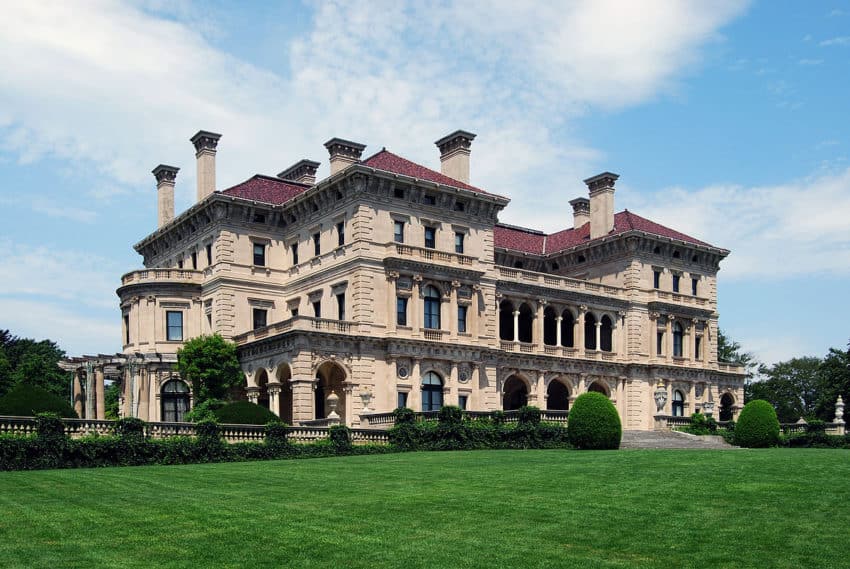
We continue along stately Bellevue Avenue and turn left up Narragansett Avenue to what attracts most visitors to Newport. In the mid-19th century, wealthy Southerners wanting to escape their steamy summers built summer homes on Bellevue. Then came the wealthy Yankees who went one step up and built mansions along the north shore facing the ocean. Today the mansions remain, a remnant of America’s Gilded Age. We pass monstrous French-style chateaus, Italian-style piazzas and Elizabethan-style manor houses, many surrounded by American-style fuck-you fences. Running along the north end is the Cliff Walk that offers stupendous views of the mansions on one side and the deep, blue Atlantic on the other.
The crown jewel of Newport’s long mansion necklace is The Breakers. It’s a 70-room, five-story Italian Renaissance palace sitting on 14 acres near the far northeast end of the peninsula. It has 20 bathrooms with 15 bedrooms on the second and third floor that housed the 40 servants. Marina and I walk in and above us are four giant chandeliers with 16 bulbs each. The opera house in Paris inspired the fountains and curving staircase. The dining room is the size of a ballroom with two huge chandeliers over a 10-foot-by-10-foot table decorated with Baccarat crystal. The columns throughout the house are solid alabaster. The walls are made from the famed cipollino marble in Italy, the same marble Michelangelo used. One bathtub is cut from a single block of marble. Every light fixture is fitted for gas in case the electricity ever goes out. If everything goes black, there’s a six-foot-high fireplace.
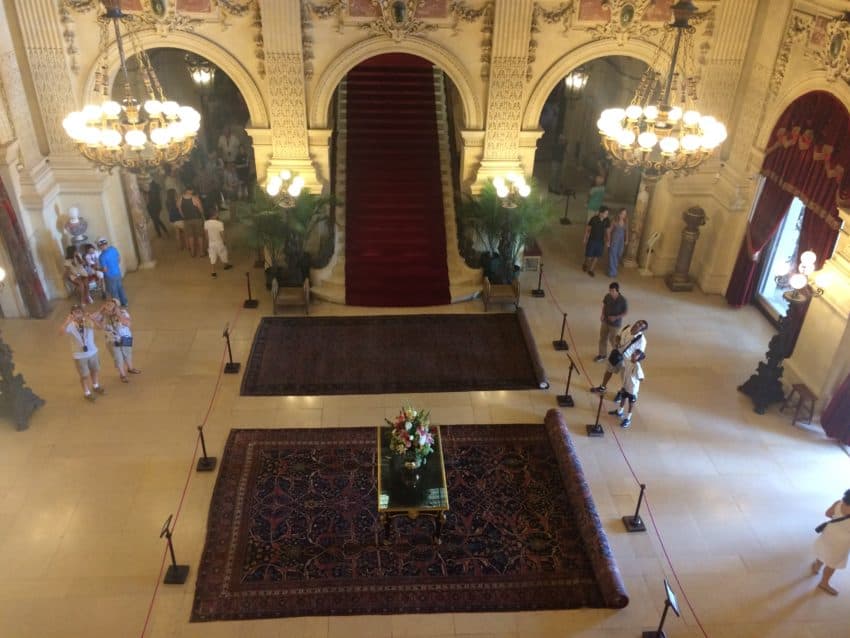
In 1855 Cornelius Vanderbilt III bought the grounds for $450,000 (about $12 million today) from money he earned in his huge New York Central Railroad empire. He hired famed architect Richard Morris Hunt to build a mansion befitting his label of “New Renaissance in the U.S.” Vanderbilt held huge parties on the gargantuan lawn that separates the home from the ocean. Walking around the grass you feel like you should be holding a champagne flute. CNN broadcaster Anderson Cooper is Vanderbilt’s great, great, great grandson and is said to have stayed here on a few occasions.
Yes, Newport oozes money like honey squeezed from a tube. We see candy apple-red Ferrari convertibles and men whose shoes, shorts, matching sweater and shades are worth more than my entire wardrobe in Rome. The Brooks Brothers store has an elaborate flower garden in front of it. The city buses are as elaborately decorated as San Francisco cable cars. People rent cars that look like Lamborghinis.

But unlike in Monaco, where everyone lies to impress each other, Newport’s populace is as down to earth as the mansions’ lawns that could pass for fairways at Augusta National. Newport originated in the 17th century as a place where people could escape religious persecution. Everyone is welcome in Newport. People kayak and bicycle and jog. They barbecue on their porches. Peter cooked us incredible teriyaki swordfish one night; Gretchen cooked us massive scallops the next. Locals drink beer and watch the Newport Gulls, the highly popular college summer-league team that plays in 81-year-old Cardines Field sporting a retro sign reading “BASEBALL GAME TODAY.” One block off the ritzy harbor, the east end of Thames Street sports old-fashioned barber shops, take-away pizza joints and an old-fashioned malt shop called Gary’s Handy Lunch that serves one of the better cheeseburgers I’ve had. Even Marina, a third-generation Roman, said the tomato pizza slice at little Via Via “was great and similar to pizza in Rome on the street.”
We drive through Brenton Point State Park, on the southeast corner where people fly kites in an expansive grass area across Ocean Avenue from the Rhode Island Sound. People picnic. I see a kid playing with a yo-yo. We drink a Rhode Island tradition, Del’s frozen lemonade, from a truck stand. Newport is like a sultan’s palace with a country town right across the street.
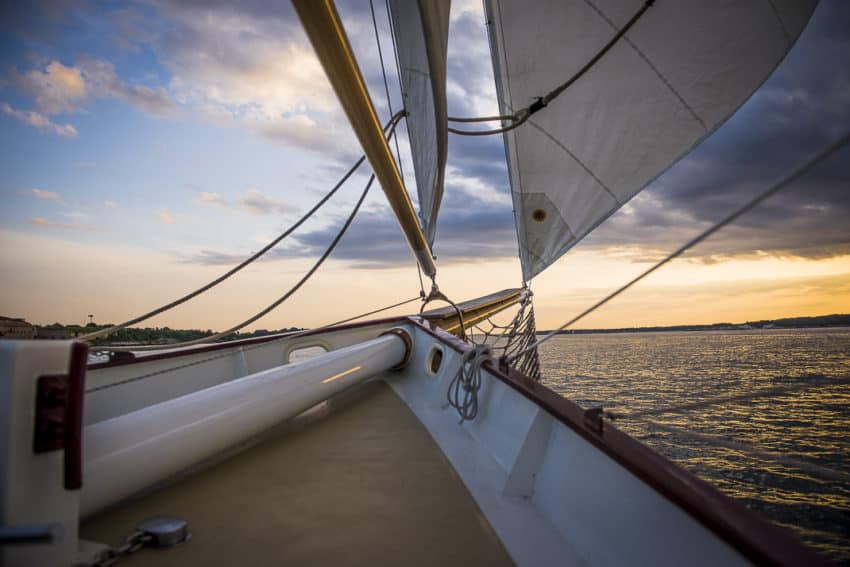
After seeing so much water, we decide to get on it. The Aquidneck is the longest boat for harbor cruises in Newport at 80 feet long. We leave at 6:15 p.m. with a full boat and jovial crew who start passing out beer and champagne before we barely exit the slip. The Aquidneck is modeled after a 17th century storage vessel that was used to mail cargo up and down the coast. “It was the FedEx of its time,” one of the sailing guide says.
We pass Fort Adams which was built in 1851 and lasted through five wars but never fired a shot.
“The only thing fought at Fort Adams was boredom,” the guide says.
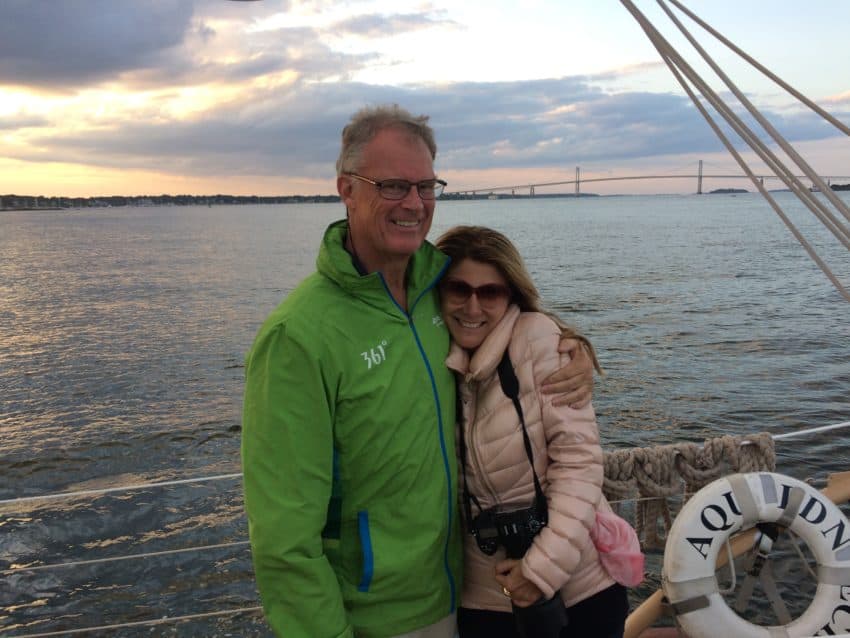
The sun is starting to set through the clouds as a party boat motors past playing Earth, Wind & Fire’s “September.” We pass the mansions standing like castles on grassy lawns. Seagulls fly through the setting sun slowly as if basking in the dwindling warmth. The temperature is in the high 60s but with champagne and Marina at my side, it feels much warmer.
Rome is paradise. But it’s paradise with flaws. The only flaw Newport has is maybe it’s too perfect. It’s like you’re afraid to knock a gum wrapper on the spotless street or you’ll suddenly burst into flames. Even the birds seem happy here. The opulence is gaudy. But you don’t have to be a member of the New York Yacht Club or bathe in a marble bathtub to enjoy Newport. All it takes is a seat by the water and a glass of champagne.
Of course, a sailboat helps.



March 2, 2021 @ 7:46 pm
Such a magical place. I feel lucky to have been born and raised in Newport.
June 5, 2024 @ 4:39 pm
What a beautiful article. I hope you will come back to Newport and visit again soon. Please stop by IYRS School of Technology & Trades on Thames Street, IYRS is a unique place in the community and works hard to support students, the blue economy and the all-important landscape of Newport Harbor. Cheers!
June 6, 2024 @ 10:01 am
Thanks, Liz. I’d love to come back. I had a great time.
July 14, 2024 @ 1:36 am
Peter! I see the net abloom with multiple pblooms, including this fellow original, 85 presumably, fellow graduate, if in my case not quite, of abolitionist Quaker Moses Brown’s school in Providence. You’ve left Rome, I take it. Susan (sidekick I take it you have one, too, a Gretchen) will be in Little Compton again this summer, first half of August. Cell is 202-262-8019. It’s down but just momentarily. Jerry Knowles lives near by, near Padennarem. Best. PK